#chinese oracle bones
Text

"The so-called oracle bone inscriptions (jiaguwen 甲骨文 "plastron bone inscriptions") are remnants of archival documents from the late Shang period 商 (17th-11th cent. BCE) upon which records of royal divinations were carved or inscribed. The material is the plastrons (breastshields, gui fujia 龜腹甲) of tortoises or scapulae (shoulder-blades shou jiagu 獸胛骨) of different cattle. The oracle bone inscriptions are the oldest extant Chinese texts written in a perfectly developed script. Unfortunately there are no older stages of the Chinese script preserved (except some clan insignia and examples of logographs of uncertain meaning), but it appears in full maturity on the Shang oracle inscriptions." http://www.chinaknowledge.de/Literature/Historiography/oracle.html
113 notes
·
View notes
Text
The unexpected discovery of China’s earliest writing occurred when Wang Torong came down with malaria. The prescription of ‘dragon bones’ to help the healing process set off an investigation which ended up leading to the oracle bones of Yinxu, the earliest known source of Chinese writing.
Ongoing use of dragon bones in Chinese medicine raises concerns among experts, lamenting the continual depletion of potential paleontological and archaeological treasures.
#oracle bones#bones#inscriptions#China#Chinese medicine#malaria#writing#ancient#history#ancient origins
27 notes
·
View notes
Text
youtube
Oracle Bone, Shang Dynasty, October 8, 2016
Oracle Bone, Shang Dynasty, Reign of Zu Geng, c. 1191-1181 B.C.E. (Shanghai Museum, China)
Speakers: Dr. Kristen Chiem and Dr. Beth Harris.
Smarthistory
#art#art history#shang dynasty#calligraphy#oracle bone script#Shanghai Museum#Chinese#Smarthistory#history#pictogram#2nd millenium bce#Youtube#盂蘭盆#中元節#ghost festival
5 notes
·
View notes
Text
cake that says "sorry I got crazy and infodumped about scripts like my life depended on it, it felt like my life depended on it"
#owl#nobody: me: u wanna know about the connection between the phonemes of human languages and the ways to visually represent them?#it is mind blowing thay ם and ㅁ from hebrew and and hangul both mean M both have the same written form and they come from#💫completeley different families of scripts💫#they didnt have anything that led them into using even the same strokes in an agreement#our M comes from the same place as ם#which is the hieratic for based on the hieroglyphic drawing of an owl 💫#theirs comes from the chinese 口 kǒu#derived from an oracle bone script character that represented a mouth#the bone oracle character was more visually simmilar to this character ㅂ b#they are related because mbp are all consonants you use your lips to make#so they used the shape of lips#😐 mistakes were made besties but 口 means mouth
3 notes
·
View notes
Text
Oracle Bone Script - Cinnabar

Cinnabar is a mineral which can be processed into mercury.
In the past mercury was incorrectly perceived as a medicine in many cultures or a part of the elixir of immortality.
Mercury is toxic and it lead to the death of Qin Shi Huang who consumed the elixir out of the fear of death.
'..."cinnabar; vermillion; elixir; alchemy" is the keyword for Chinese immortality elixirs.' The red mineral cinnabar was anciently used to produce the pigment vermilion and the element mercury '(shuǐyín 水銀 "watery silver")'. - Wikipedia Article
#real world history#cinnabar#script#ancient history#creative writing ideas#china#chinese history#artifact#oracle bone script#mercury#hints#ancient writing#oc talk
1 note
·
View note
Text
Η ιστορία της κινεζικής γραφής
Η κινεζική γραφή έχει μια πλούσια και συναρπαστική ιστορία και έχει τροποποιηθεί πολλές φορές, προκειμένου να αντιπροσωπεύει τα κοινωνικά και πολιτιστικά ρεύματα της κάθε εποχής. Ένα από τα πιο πρώιμα συστήματα γραφής είναι το λεγόμενο Oracle Bone Script ( jiǎgǔwén ), όπου το όνομα περιγράφει το γεγονός πως τα περισσότερα ιδεογράμματα αυτού του είδους γράφονταν- σχεδιάζονταν πάνω σε οστά από…
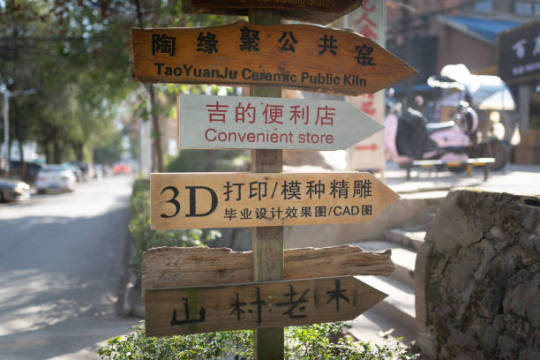
View On WordPress
0 notes
Text
culture tips for writing asian settings: calligraphy (pt ii)
in my last post i talked about calligraphy more generally, but here i want to talk about the calligraphy from atla. all of the calligraphy from the show is written by dr siu-leung lee and i'll be using the artbook as my reference.
if you're a writer or artist approaching written chinese, you can think about how script and handwriting might tell us something about a character. dr lee certainly did, and he even tailored writing styles to who he thought might've been writing that text: "If it were a highly cultured royal attendant, he would use a refined, elegant style, but if it were a low-level clerk, he would use a more pedestrian handwriting style."
first thing: modern standard chinese coming out of mainland china uses simplified chinese. this system was developed in the mid-20th century, so it's pretty anachronistic to use this for atla. instead, you should be using traditional chinese as dr lee does (which is still used in hong kong, taiwan, and many diasporic communities). i usually use google translate to switch between the systems.

note the use of simplified 门 (door) instead of the traditional 門 from the aang's unfreezing day comic.
next i'm going to take aang's wanted poster as an example of three different chinese scripts we see in the show. the "title" is in clerical script, the body of the text is in regular script, and the seal is in seal script.

regular script is the standard way you'd learn how to write chinese nowadays. you can see (as i mentioned in part i) how the text is meant to be read up -> down, then right -> left.
clerical script is characterised by fairly compact shapes and a kind of "roundness", and was developed in the late warring states period. this is the script used for the chinese title of the show! in the context of atla, it implies to me that the writer has more specialised calligraphic training than the average person (who, if they can write, would be using regular script). you can compare the difference in styles for the same words between clerical (L) and regular (R):


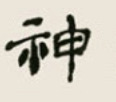

seal script is the most archaic form of chinese on display; this one wouldn't have been written by the calligrapher, but carved into a seal by a craftsperson and then stamped onto the page.
what's also really interesting is dr lee implies a difference in script between the nations. some of the characters used to write water tribe-related concepts:

this is an adapted form of oracle bone script, the one of the earliest forms of chinese writing. this fascinated me because this script was—as the name suggests—written on bone, and perhaps reflects something about the material of what the water tribes were using to write. (you can input modern characters into this website to see examples of their older forms.)
finally, some cool differences in handwriting! this is from the fire day festival poster:

this uses regular script, but in contrast to the excerpt we saw before, the formation of the characters is more haphazard (excitable?). it's also written left -> right! this suggests to us the writer is a commoner, as opposed to a royal scribe.
these are some things you can keep in mind when you're writing or drawing in this universe—while you're probably writing in english, the characters would be steeped in the writing systems we've been talking about. if a character's sending a letter, what might the recipient notice about the handwriting? what does it tell them about their social status or education? could the shape of the letters signal something about where they come from, i.e. water tribe characters write a more curvy script?
disclaimer | more tips
584 notes
·
View notes
Text
[Hanfu · 漢服]Chinese immortal Hanfu <西王母/Queen Mother of the West> Based On Yuan Dynasty Taoist Temple Mural<永乐宫/Yongle Palace>
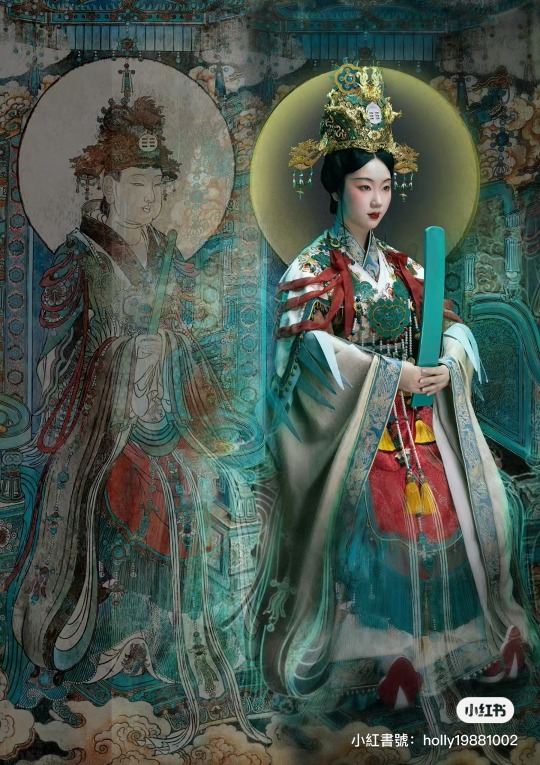
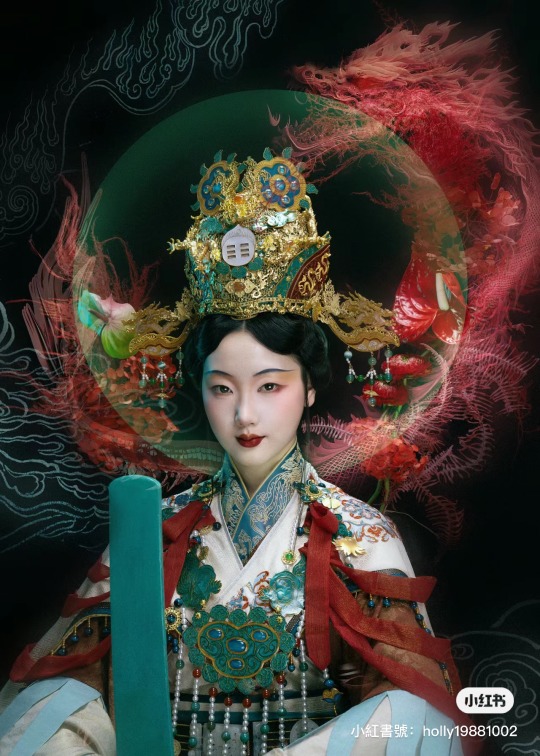
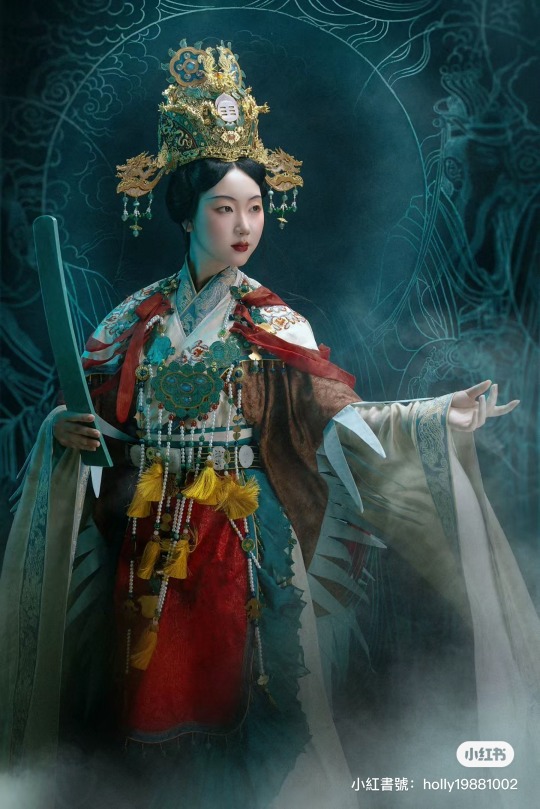
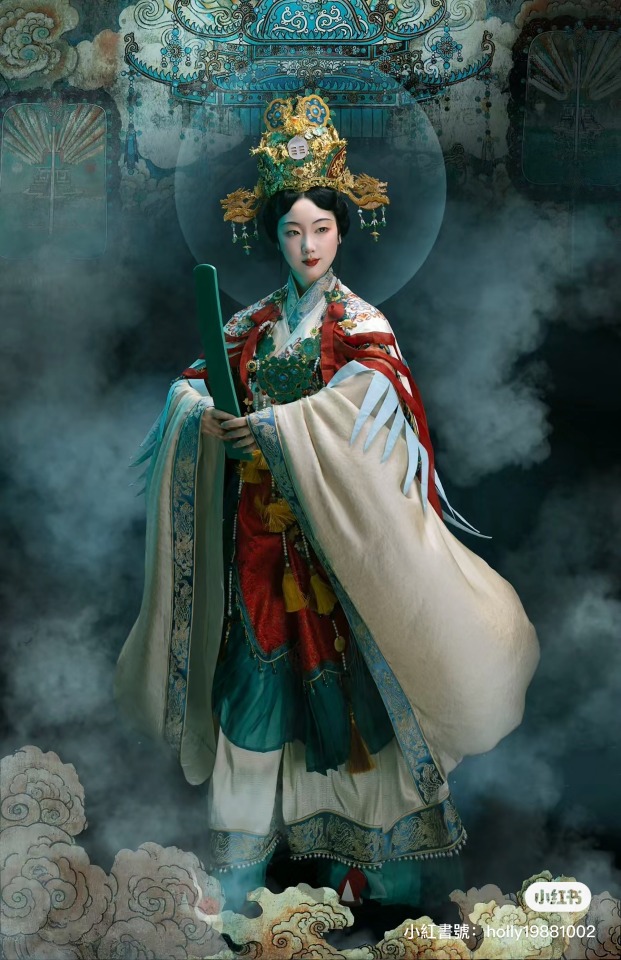
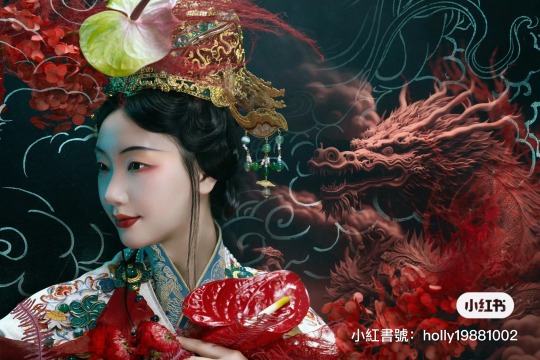
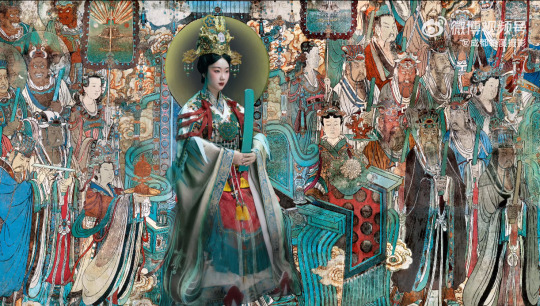
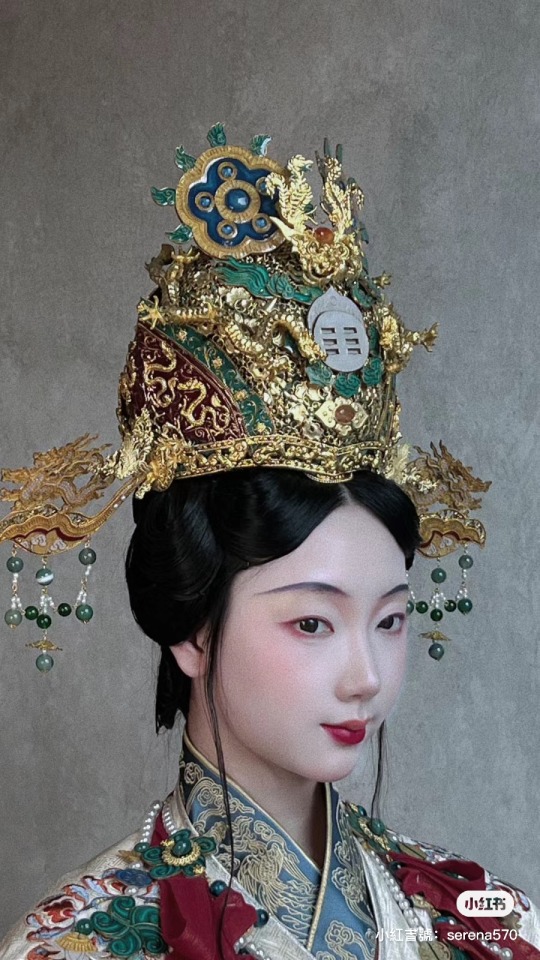
【Historical Artifacts Reference 】:
▶ China Yuan Dynasty Taoist Temple 永乐宫/Yongle Palace Mural


<西王母/Queen Mother of the West>
The Queen Mother of the West, known by various local names, is a mother goddess in Chinese religion and mythology, also worshipped in neighbouring Asian countries, and attested from ancient times.
The first mentions of the Queen Mother date back to the oracle bone inscriptions of the Shang dynasty (1766 – 1122 BCE).
One inscription reads:
Crack-making on day IX (9th day), we divined. If we make offering to the eastern mother and the western mother, there will be approval.
Western Mother refers to an archaic divinity residing in the west. The exact nature of the Mother divinities in the Shang dynasty is unclear, but they were seen as powerful forces deserving of ritual by the people of the Shang dynasty.
Originally, from the earliest known depictions of her in accounts like the Classic of Mountains and Seas during the Zhou dynasty, she was a ferocious goddess of death with the teeth of a tiger, who rules over wild beasts and sends down heavenly punishments such as pestilences. She was also mentioned as an authority ruling over other divinities such as Jiutian Xuannü, a goddess of war and sex.
Other stories hold that she is a mountain goddess or a divine tigress. She is also popularly thought to have blessed the Eight Immortals with their supernatural abilities.
After her integration into the Taoist pantheon, she gradually took on associations with other aspects, such as immortality, as well.
The Queen Mother of the West is most often depicted holding court within her palace on the mythological Mount Kunlun, usually supposed to be in western China (a modern Mount Kunlun is named after this). Her palace is believed to be a perfect and complete paradise, where it was used as a meeting place for the deities and a cosmic pillar where communications between deities and humans were possible.At her palace she was surrounded by a female retinue of prominent goddesses and spiritual attendants. One of her symbols is the Big Dipper.
Although not definite there are many beliefs that her garden had a special orchard of longevity peaches which would ripen once every three thousand years,others believe though that her court on Mount Kunlun was nearby to the orchard of the Peaches of Immortality. No matter where the peaches were located, the Queen Mother of the West is widely known for serving peaches to her guests, which would then make them immortal. She normally wears a distinctive headdress with the Peaches of Immortality suspended from it.
Flourishing parasols, we reach the chronograms' extremity;
Riding on the mist, I wander to Lofty Whirlwind Peak.
The Lady of the Supreme Primordial descends through jade interior doors;
The Queen Mother opens her Blue-gem Palace.
Celestial people—What a Crowd!
A lofty meeting inside the Cyan Audience Hall.
Arrayed Attendants perform Cloud Songs;
Realized intonations fill the Grand Empty Space.
Every thousand years, her purple crabapple ripens;
Every four kalpas, her numinous melon produces abundantly.
This music differs from that at the feast in the wilderness—
So convivial, and certainly infinite.— Wu Yun (Complete Tang Poems 1967, line 4942)
One of the earliest written references to the Queen Mother comes from the writings of the Taoist writer Zhuangzi (c. 4th century BCE):
The Queen Mother of the West obtained it [the Dao]... ...and took up her seat at Shao kuang. No one knows her beginning; no one knows her end.
Zhuangzi describes the Queen Mother as one of the highest of the deities, meaning she had gained immortality and celestial powers. Zhuangzi also states that Xiwangmu is seated upon a spiritual western mountain range, suggesting she is connected to not only the heavens, but also to the west.
Legendary encounters
In Tu Kuang-ting's text, he includes narrative accounts of the Queen Mother's encounters with legendary Chinese heroes. One such account narrates an encounter between the Queen Mother and Laozi (Lord Lao):
"In the 25th year of King Chao of the Chou dynasty (1028 BCE) …"
"…Lord Lao and the realized person Yin Hsi went traveling…"
"…on their behalf, the Queen Mother of the West explicated the Scripture of Constant Purity and Quiet."
In this account, the Queen Mother plays the role of Laozi's superior and is credited with the ultimate authorship of the Dao De Jing. This dichotomy of the Queen Mother as the superior is a characteristic of Shangqing Taoism, a goddess worshiping sect of Taoism of which Tu Kuang-ting was a master. There is also an account of a meeting between the Queen Mother and Laozi in Tang poetry.[18] This account however, being of traditional Taoist thought, has the Queen Mother taking an inferior role to Laozi, calling him "Primordial Lord" (the title of his highest manifestation) and pays homage to the sage.

<China Han Dynasty stone-relief showing 西王母/Queen Mother of the West from Sichuan,China>

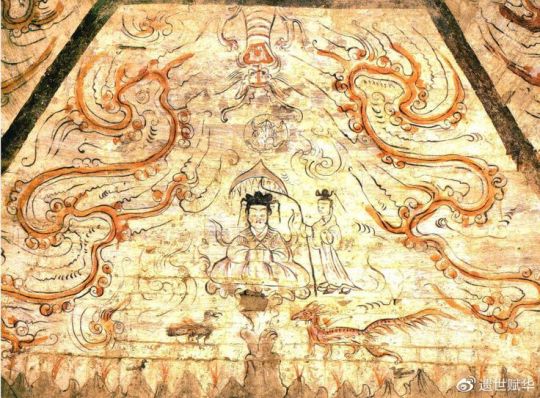
<China Wei and Jin Dynasties Mural showing 西王母/Queen Mother of the West>
————————
📸Photography post-production :@小何力
👗Hanfu & 👑Crown:@雁鸿Aimee
💄 Makeup:百丽 (临溪摄影)
👭Model:@清音音音音
🔗 Weibo:https://weibo.com/1648616372/O2R5bpBud
————————
#chinese hanfu#immortal hanfu#西王母/Queen Mother of the West#Chinese mythology#hanfu#hanfu accessories#hanfu_challenge#chinese traditional clothing#china#chinese#chinese history#china history#漢服#汉服#中華風#小何力#雁鸿Aimee#永乐宫/Yongle Palace
234 notes
·
View notes
Text
Some examples of Chinese "oracle bones," which were used to find out the future or discern the will of the gods during the Shang Dynasty of the 1000s BCE.
As far as historians can tell, the divination ceremony worked like this: priests, under the supervision of the king himself, would select a bone, usually a flat one like the chest plate of a turtle shell or the scapula of an ox. They would write a statement on the bone for the gods to confirm or deny.

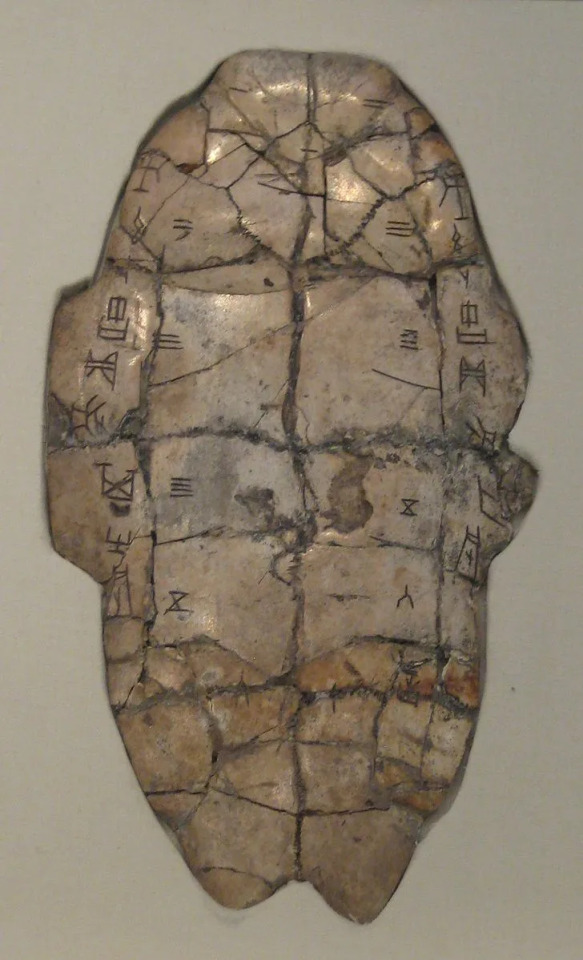
Much more on the ancient and modern arts of divination here:
{Buy me a coffee} {WHF} {Medium} {Looking Through the Past}
194 notes
·
View notes
Note
Hi ge, hope all is well. I seem to remember you did like an etymology post for the character gǒu. Could you do a similar one for 龙 when you have a minute? Thanks! Was curious as to the pictographic representations it evolved from.
Sure!
[**I'm summarising/translating from Baidu, wikipedia, and hanziyuan btw**]

Variants of the words 龙/lóng (龍) can be found as early as oracle bone script (甲骨文) from the Shang dynasty (1600 BCE - 1046 BCE).
Above: (1-2) Shang dynasty variant; (3-4) Western Zhou; (5-6) Warring States; (7) 小篆 /Qin seal script variant as seen also in 说文解字, a Han dynasty dictionary compiled in 100 CE; (8) Han clerical script; regular script, traditional (楷书) ; regular script, simplified.
Text at the bottom of the above images cites pages from the dictionaries and pages that the characters can be found in.
龙 is catergorised as a pictogram (象形字), a character that is derived from a picture, so unlike the word 狗, which is phono-semantic (形声字), its composition is unique and you can't breakdown the components to find sound or meaning. There are six methods of character formation (造字法/六书) in Chinese: pictogram (象形), ideogram (指事), combined ideogram (会意), phono-semantic (形声), transfer character/mutually explanatory (转注), and loan (假借).
The character 龙 originally and mainly refers to a mythological creature with a long body, horns, scales of a fish, claws, the ability to fly as well as swim, as well as the power to gather clouds and cause rain.
In oracle bone script, two variants of the character initially emerged (depicted above, labeled A and B), meant to illustrate the "real" appearance of the mythological creature. Later oracle bone scripts would simplify the body and a 辛 character would begin to emerge at the head. Oracle characters and bronze characters (characters inscribed in bronze) would appear similar, with the main difference being that bronze characters often included several "teeth" in the long's mouth:

Oracle bone script variants (甲骨文)

Bronze character variants (金文)
From oracle bone and bronze to seal script and beyond, the character become more complex, with what were once teeth forming the component 月 from 肉, the ribs (flesh), and the head of the long being realised as a 立, from 王 (king). With seal script, the character transformed into a blockier shape, reaching an earlier variant of the traditional regular script 龍.
A Sui dynasty non-standard variant of 龍 was 尨 , which could also sometimes be written with just two 撇/pie (the left slanting strokes). When creating the simplified version of the character, another 撇 was done away with, creating 龙.
Other variants from classical Chinese (古文):

竜、𦱉、𢅛、𠊋、㰍、𥫈、龒、䰱
Pronunciation of the character can be found in the 2nd century dictionary 说文解字 Shuowen jiezi;
【龍部】力鍾切 - (lì zhōng);
切 in such dictionaries stands for 反切 fanqie; this means pronunciation is indicated by combining the two other characters; li + zhong = lóng
Sources:
baidu article
hanziyuan
166 notes
·
View notes
Text
“How Often Does Such a Bright Moon Come Around?” (水調歌頭 · 明月幾時有) Translation
(Another year, another Mid-Autumn Festival, another poem translation. This particular poem is very famous because of the first and last lines, which are frequently referenced in popular culture. Happy Mid-Autumn Festival!)
How often does such a bright moon come around?
By Su Shi (Song dynasty, 1076 AD)
Mid-Autumn of the year Bingchen (2), drank all night in celebration, became heavily inebriated. Composed this poem to commemorate this occasion, and in dedication to Ziyou (3). (4)
How often does such a bright moon come around? With wine in hand, I ask the heavens.
Wondering what year it is for this day in heaven (5), in the palace high above.
Wishing to ascend on the wind, yet I cannot stand the chilly air around those lofty towers of jade.
Dancing and amused at my own crisp shadow, the frigid heavens surely cannot compare to the mortal realm below.
Rounding the vermilion building, hanging low near the intricate windows, the moon casts light over the sleepless (6).
The moon should not feel bitter jealousy, so why is it only full on parting?
Humans feel grief and joy, partings and reunions, just as the moon waxes and wanes.
For both of these heartening things (7) to happen together is very rare indeed.
May we be blessed with longevity, so that even when thousands of li (8) apart, we can still gaze upon this wonderful moon together.
—————————-
Notes:
This poem is in the Ci/词 format, and follows the rhyme scheme (Cipai/词牌) called Shuidiaogetou/水調歌頭/水调歌头.
Bingchen/丙辰 is a year in the Chinese Sexagenary Cycle, which is known in Chinese as Tiangandizhi/天干地支 ("Heavenly Stems and Earthly Branches") or simply Ganzhi/干支 ("Stems and Branches"), and is used to record time. This system has been in use since at least the Shang dynasty around 3000 years ago (oracle bone artifact bearing inscriptions of ganzhi has been found at Yinxu/殷墟, the archaeological site of the ancient capital of Shang dynasty; however, during Shang dynasty the Ganzhi system was used to track days and not years, unlike how it has been used in later times). Because there are 60 years in one cycle, it is possible to trace back to specific years. In this case, Bingchen would be exactly 1076 AD.
Ziyou/子由 is the courtesy name of Su Shi's brother, Su Zhe/蘇轍.
This section is a short introduction to the poem, which begins after this section.
This may be a reference to the concept that "a day in heaven is a year on earth" ("天上一天,地上一年"; famously included in Journey to the West), which in turn is a reference to the ecliptic plane (called Huangdao/黄道 in Chinese), since for an observer on Earth, the Sun appears to move in an elliptical path throughout the year. This means that it takes a year (i.e. "a year on earth") for the Sun to "complete" one round in this elliptical path (i.e. "a day in heaven").
Here, "the sleepless" is a reference to the poet himself.
"Both of these heartening things" refers to reunion with family and/or friend, and the occurence of a full moon.
Li/里 is a traditional unit of distance. During Su Shi's time (Northern Song dynasty, 960 AD - 1279 AD), 1 Li ≈ 576 meters = 0.576 km or 0.36 miles (Note: link leads to pdf).
—————————-
Original Text (Traditional Chinese):
《 水調歌頭 (1) · 明月幾時有 》
[宋] 蘇軾
丙辰中秋,歡飲達旦,大醉,作此篇,兼懷子由。
明月幾時有?把酒問青天。不知天上宮闕,今夕是何年。
我欲乘風歸去,惟恐瓊樓玉宇,高處不勝寒。起舞弄清影,何似在人間。
轉朱閣,低綺戶,照無眠。不應有恨,何事長向別時圓?
人有悲歡離合,月有陰晴圓缺,此事古難全。但願人長久,千里共嬋娟。
#mid autumn festival#midautumnfestival#chinese poem#poetry#how often does such a bright moon come around#my translation#明月几时有#苏轼
171 notes
·
View notes
Photo
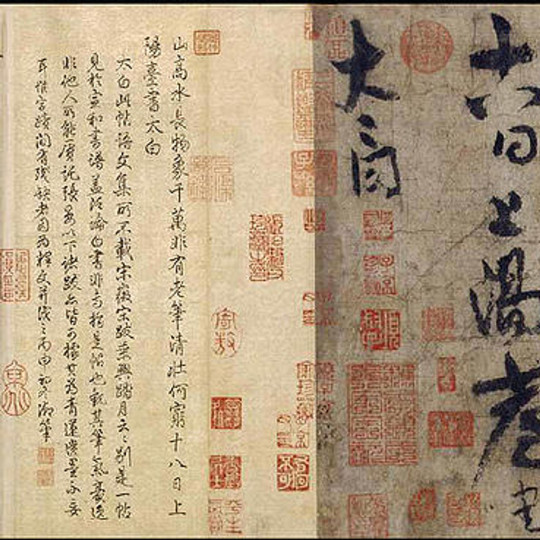
History of Chinese Literature
Ancient Chinese literature developed following the evolution of script which evolved from divination practices of the Shang Dynasty (1600-1046 BCE). The pictographs made on oracle bones by diviners became the script known as Jiaguwen (c. 1600-1000 BCE) which developed into Dazhuan (c. 1000-700 BCE), Xiaozhuan (700 BCE - present), and Lishu (the so-called "Clerky Script", c. 500 BCE).
From these came Kaishu, Xingshu, and Caoshu, cursive scripts which writers later used in prose and poetry to create the great works of Chinese literature. The following collection presents a brief overview of this development.
Continue reading...
39 notes
·
View notes
Note
I think it's pretty impressive that China is the only one of the 6 civilizations that developed independently that maintained linguistic continuity to the modern day. Egypt got arabized, mesopotamia got akkadian and then aramaic and then arabic, we don't really know what language Norte Chico spoke but it certainly wasn't Quechua, the Olmecs were replaced by the Toltecs and then the Mixtecs and then the Aztecs and then the Spanish (there's still million of Nahuatl speakers but still), we don't know what language the Indus River Valley Civilization spoke but it certainty wasn't Indo-Iranian. But China used to speak old Chinese and now it speaks mandarin and other sinitic languages, written with a writing system descended from the Oracle Bone Script. That's pretty cool.
Turns out being fairly far away from europe has its benefits!
35 notes
·
View notes
Note
How many times did writing systems individually evolve?
Writing has been independently invented at least three times in human history: once in Mesoamerica, once in Mesopotamia/Egypt, and once in China.
The only script from Mesoamerica that has been deciphered is the Maya script, attested from around 200BC until the time of the Spanish conquest, when (to my understanding) the scribes were all either killed or retrained in writing Spanish and knowledge of the script was lost. It was subsequently deciphered again in the late 20th century, though the corpus is fairly small (most of it epigraphic) as only a handful of codices remain. Earlier, undeciphered forms of writing or proto-writing predate the Maya script in Mesoamerica, such as the (Epi-)Olmec script.
The situation in the Ancient Near East is a bit more complex. Two extremely early forms of writing are attested there, Egyptian hieroglyphs (in Egypt) and Sumerian cuneiform (in Mesopotamia). Both date from the end of the third millennium BC (that is, c. 3000BC), and one or the other has the claim to being the first writing system ever invented. My impression is that every once in a while they'll dig up an inscription from Egypt that sets the date back a little and makes Egyptian the oldest, then they'll dig up something from Mesopotamia that makes Sumerian the oldest, back and forth. But I don't know the details, maybe an Egyptologist or Sumeriologist can come in here and confirm or deny.
Anyway, one of the great things about cuneiform in particular is that there is a clear archeological record of its emergence out of proto-writing. So, linguists and epigraphers say that some system of symbols is a "writing system" when it can be used to represent a spoken language in its totality. For instance, English writing can represent any spoken English sentence, so it counts. If a system cannot systematically represent speech, but is still used for more limited kinds of communication or record keeping, it is dubbed "proto-writing". All writing systems are thought to have emerged out of earlier systems of proto-writing, in which symbols were used iconographically in various ways, before becoming fully systematized and coming to represent spoken words. With cuneiform, there is a record of this whole transitional process, which has probably informed theories about the development of writing generally more than anything else.
In any case, Egyptian hieroglyphs and Sumerian cuneiform emerged side by side at about the same time, so it is generally thought that their development was subject at least to cross-influence of various kinds, and thus they should not be counted as wholly separate "inventions of writing". But I don't know the details of this.
The last case in which writing was independently invented was in ancient China, with the oracle bone script, attested from about 1200BC. By the time of its first attestation, however, the oracle bone script was already very systematized and complex, leading most scholars to believe that it must have been in use for several centuries before the earliest extant examples. One way or another, unlike the previously mentioned scripts, the details of its initial development and any possible predecessor systems are totally unknown. Another difference is this: the Maya script and cuneiform both completely died out, leaving no descendants in use today. Egyptian hieroglyphs also died out, although if it is in fact true that the proto-Canaanite script is adapted from hieroglyphs, then they left many indirect descendants (including the Latin characters I am using right now!). The oracle bone script, on the other hand, evolved directly into modern Chinese characters, which are used today to write Chinese and Japanese (in the form of kanji) and formerly also Korean (hanja) and Vietnamese (chữ Nôm).
More cases of independent invention are possible, but are unconfirmed. Systems like the Vinča symbols are so old that they went out of use before cuneiform even developed, but they are generally regarded as being in all likelihood examples of proto-writing and not true writing systems. The Indus Valley Civilization had some symbols, but they are also undeciphered and are also probably not true writing. The Brahmi script of ancient India (c. 300BC) is sometimes argued to be an independent invention, but similarities to Aramaic have led many to believe it was at least influenced by earlier Semitic scripts (themselves all descended from proto-Canaanite, and thus, putatively, from Egyptian hieroglyphs). Rongorongo may be a writing system independently invented in Rapa Nui (Easter Island), but again it remains undeciphered and may be proto-writing. There are probably various other such examples.
Anyway, the answer to "how many times did writing systems independently develop" is "at least three, maybe a few more".
108 notes
·
View notes
Note
About Wukong and reading: I headcannon that he could read ANCIENT Chinese really well, the stuff that was on tortoise shells and oracle bones. It's just that after the language changed and evolved he never bothered to relearn it. Then in your AU he's forced to once MK gets old enough to read because he doesn't want to learn if Baba doesn't have to. At that point, Tang makes him sit down and learn letters and characters with the toddler.
100% agree. Wukong knows the type of ancient chinese + a punch of dead dialects that didn't make it into the modern day. Modern and simplified chinese writing is really hard for him to just pick up and learn all over again. He's a lot better at picking up the verbal changes in languages. Also he doesn't want to look dumb (self-esteem issue).
Pigsy figured Wukong only wrote in really traditional chinese + drawings cus thats all he knew. Probably helped teach Wukong some basic simplified to make food orders more legible.
Macaque knows a little more modern chinese, but barely since he got cut-off with the Tang-dynasty. He probably gives himself a brain overload trying to catch up with all the written language changes. Was def the second biggest advocate of Wukong learning modern writing.
Later ofc, little MK (+Mei) would demand that Baba sit and learn with they or else they wont. Nezha and Chen Xiang argue in their defence - mostly cus Tang is making them brush up on it too (both are from ancient china as well).
Wukong could be minding his own business and get ambushed by Tang holding up one of the toddlers' flash cards like; "
Tang: Halt! What does this character mean?"
SWK, panicking: "Uhh...uh..! Dirt?"
Tang: "Correct!" *tosses SWK a peach chip like its a scooby snack*
It does lead to the kids demanding treats with their learning time though. Macaque and Tang just laugh and trick the toddlers into accepting mini-rice cakes.
#lego monkie kid#lmk#the monkey king and the infant#the monkey king and the infant au#sun wukong#lmk character hcs#qi xiaotian#lmk tang#liu er mihou#six eared macaque
94 notes
·
View notes
Text
can we talk about how
in the explanation of what the scroll is there are so many constellations
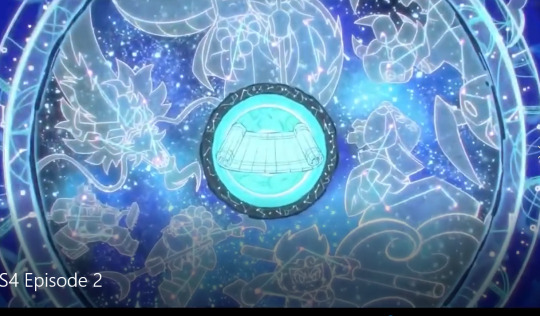
and during MK’s little Flashback moment in ep6 we see these animal figurines;
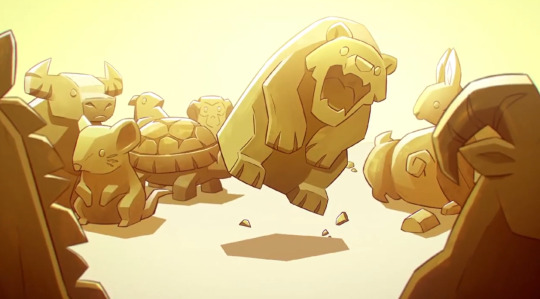
which, outside of the bear (possibly Ursa Major or another bear themed constellation I’m unaware of?) and the turtle (The Black Tortoise, one of the four symbols of the Chinese constellations), the other animal figurines in this scene are all part of the Zodiac.
And y’know. If we take that, and apply the fact that the Oracle Bone Script written on the Scroll supposedly translates to the Zodiac...
Two times is a coincidence, but three times is a pattern.
335 notes
·
View notes